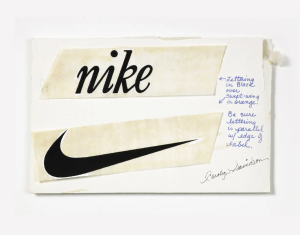
The Nike Swoosh: Who Created the Iconic Logo and Its Enduring Impact
Discover the story behind the Nike Swoosh, designed by a college student for $35, now one of the most recognizable logos in the world.
Beaverton, OR – The Nike Swoosh, a simple yet dynamic checkmark, is more than just a logo—it’s a global symbol of athleticism, ambition, and innovation. Synonymous with Nike, the world’s leading sportswear brand, the Swoosh adorns everything from sneakers to billboards. But who created this iconic design, and how did it become a cultural juggernaut? In 2025, as Nike celebrates over 50 years of dominance, we dive into the origin story of the Swoosh, its creator, and its evolution.
Who Designed the Nike Swoosh?

The Nike Swoosh was designed in 1971 by Carolyn Davidson, a graphic design student at Portland State University. At the time, Nike was still called Blue Ribbon Sports (BRS), a small distributor of Japanese running shoes founded by Phil Knight and Bill Bowerman. Knight, a business instructor at PSU, overheard Davidson lamenting her inability to afford oil painting supplies and offered her freelance work designing a logo for a new footwear line.

Davidson’s brief was simple but vague: create a logo that conveyed motion and looked good on a shoe. Working in her spare time, she sketched various concepts, eventually presenting a series of designs to Knight and his team. The Swoosh—a fluid, wing-like curve inspired by the Greek goddess Nike’s wing—was chosen, though Knight famously remarked, “I don’t love it, but it’ll grow on me.” Davidson was paid $35 for her work, equivalent to about $260 in 2025 dollars.
The Birth of a Brand
The Swoosh debuted in 1972 on Nike’s first original shoe, the Nike Cortez, at the U.S. Olympic Trials. Its sleek design, symbolizing speed and grace, quickly caught attention. As BRS rebranded to Nike, Inc., the Swoosh became the company’s defining emblem. By 1978, Nike was a rising star in athletic wear, and the logo’s versatility—bold yet minimalist—made it ideal for apparel, equipment, and marketing.
In 1983, recognizing Davidson’s contribution as Nike’s valuation soared, Phil Knight invited her to a company event. To her surprise, he gifted her 500 shares of Nike stock (worth over $1 million today after splits) and a diamond-encrusted Swoosh ring. Davidson, now retired in Oregon, remains humble about her role, noting in a 2016 interview with Fast Company, “I never expected it to become this big.”
Why the Swoosh Works
The Swoosh’s genius lies in its simplicity and universality. Graphic design experts praise its ability to evoke motion and energy without a single word. Unlike complex logos, the Swoosh is instantly recognizable, scalable, and adaptable across cultures. Its curved shape aligns with psychological principles of positive emotion, making it approachable yet aspirational. In 2025, it remains one of the few logos that needs no text to convey brand identity, rivaling the likes of Apple’s bitten apple or McDonald’s golden arches.
Nike’s marketing amplified the Swoosh’s power. Campaigns like “Just Do It” (launched in 1988) and endorsements from icons like Michael Jordan, Serena Williams, and Cristiano Ronaldo embedded the logo in global pop culture. The Swoosh has appeared on Olympic podiums, NBA courts, and streetwear, cementing Nike’s $53 billion valuation in 2025, per Forbes.
Evolution and Cultural Impact
While the Swoosh has remained largely unchanged, Nike has experimented with its presentation. In 1995, the logo was officially decoupled from the Nike wordmark for standalone use, a bold move that underscored its strength. Special editions, like the rainbow Swoosh for Pride or metallic versions for premium sneakers, keep it fresh. Collaborations with designers like Virgil Abloh and brands like Supreme have elevated the Swoosh to high fashion, while its presence in virtual spaces, like Nike’s Nikeland on Roblox, shows its digital adaptability.
The Swoosh hasn’t been without controversy. Nike’s labor practices in the 1990s sparked debates, with some activists defacing the logo in protests. However, Nike’s pivot to sustainability—using recycled materials in 80% of its products by 2025—has restored much of its goodwill. The Swoosh now symbolizes not just athletic excellence but also social impact, with initiatives like the Nike Community Impact Fund supporting underserved youth.
Key Facts About the Nike Swoosh
- Creator: Carolyn Davidson, a Portland State University student, in 1971.
- Original Cost: $35, later rewarded with stock worth millions.
- Inspiration: The wing of Nike, the Greek goddess of victory.
- Impact: Powers a $53 billion brand, recognized in over 190 countries.
The Swoosh in 2025 and Beyond
As Nike navigates a competitive landscape with rivals like Adidas and Under Armour, the Swoosh remains its greatest asset. In 2025, Nike’s focus on AI-driven design and eco-friendly innovation ensures the logo’s relevance. From augmented reality sneakers to carbon-neutral factories, the Swoosh continues to symbolize progress. Carolyn Davidson’s $35 design has transcended its humble origins, proving that a single stroke can change the world.
Explore Nike’s latest collections at Nike.com and follow their journey on social media for exclusive Swoosh-inspired content.
Check out more art & lifestyle content here

